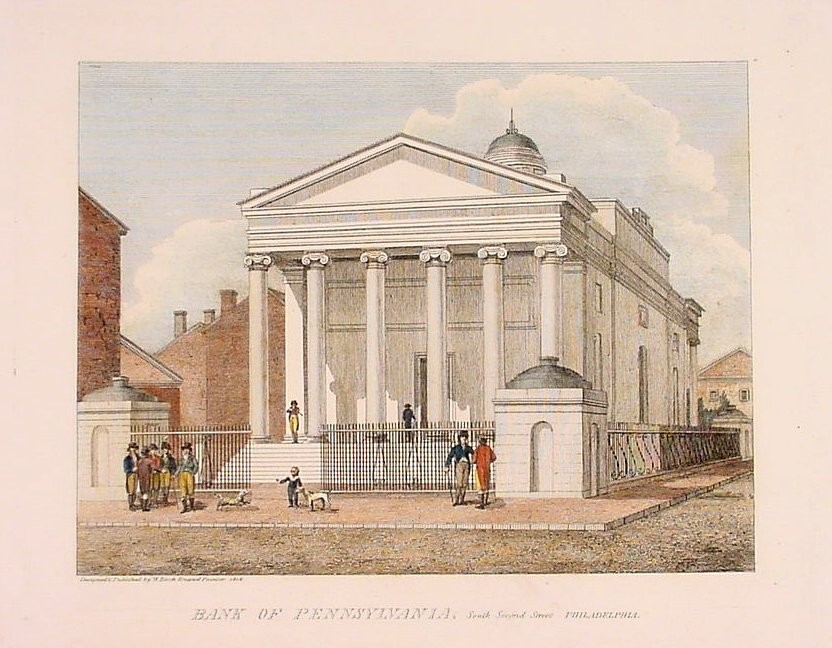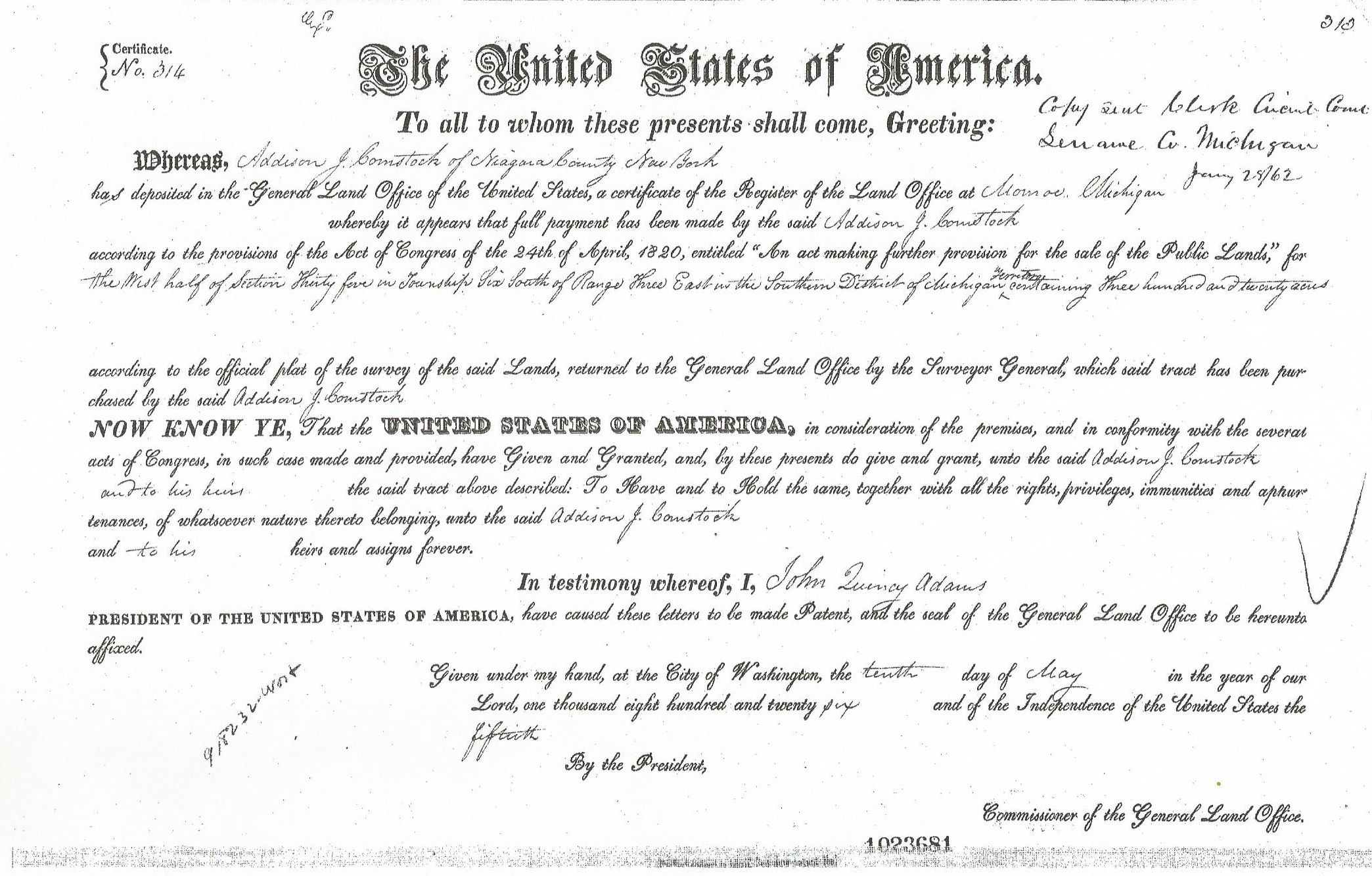|
Civil War Memorial (Adrian, Michigan)
The Civil War Memorial is a marble monument situated in the center of Memorial Park in Adrian, Michigan. The monument was designated as a Michigan Historic Site on August 13, 1971 and later added to the National Register of Historic Places on June 29, 1972. It was unveiled on July 4, 1870 to commemorate soldiers from Adrian who died in the American Civil War (1861–1865). History The Civil War Memorial ties together the cities of Adrian and Philadelphia, Pennsylvania. The column used in the monument was originally one of the six marble columns on the eastern facade of the former Bank of Pennsylvania building in Philadelphia. The bank building and the column itself were built in 1799. The Bank of Pennsylvania building, which was considered one of the first examples of Greek Revival architecture in the United States, was demolished in 1867. With Congressional permission, Joint resolution N0-78, July 27, 1868, one of the six columns was acquired by The Hon. F.C. Beeaman, m ... [...More Info...] [...Related Items...] OR: [Wikipedia] [Google] [Baidu] |
Adrian, Michigan
Adrian is a city in the U.S. state of Michigan and the county seat of Lenawee County. The population was 20,645 at the 2020 census. Adrian lies in Michigan's 7th congressional district. History Adrian was founded on June 18, 1826 by Addison Comstock. The original name for the village was Logan, but was changed soon after to Adrian, perhaps in reference to the Roman emperor Hadrian. The first operating railroad in Michigan was a horse-drawn train running between Adrian and Toledo in 1836. Adrian grew quickly, with the sixth largest population in the state when Michigan was admitted to the Union in 1837, and the third largest population in the state by 1860. Underground Railroad Evangelical and Hicksite Quakers in Southeast Michigan founded the first congregation of Quakers in Michigan in 1831. They also created a network of Underground Railroad stations in the Raisin River Valley. Daniel Smith was the first leader of the Raisin Valley Friends Meeting House. His daughter, ... [...More Info...] [...Related Items...] OR: [Wikipedia] [Google] [Baidu] |
Lenawee County, Michigan
Lenawee County ( ') is a county located in the U.S. state of Michigan. As of the 2020 United States Census, the population was 99,423. The county seat is Adrian. The county was created in 1822, from territory partitioned from Monroe County. Its governing structure was organized in 1826. Lenawee County comprises the Adrian, MI Micropolitan Statistical Area. It is served by the Toledo Media market. Lenawee County is home to the Potawatomi, Ottawa, Chippewa, Iroquois, Miami, Sauk, Fox, Mascoutens and Huron tribes. History The county owes its formation to the 1807 Treaty of Detroit, by which the Ottawa, Ojibwe (called Chippewa by the Americans); Wyandot and Potawatomi nations ceded their claims to the United States of their traditional territories in today's southeast Michigan. However, many leaders of these tribes believed that the treaty was coercive and opposed it. They began to collaborate and organize a confederacy of resistance, led by Chief Tecumseh (Shawnee). They wanted ... [...More Info...] [...Related Items...] OR: [Wikipedia] [Google] [Baidu] |
Marble Sculptures In Michigan
Marble is a metamorphic rock composed of recrystallized carbonate minerals, most commonly calcite or dolomite. Marble is typically not foliated (layered), although there are exceptions. In geology, the term ''marble'' refers to metamorphosed limestone, but its use in stonemasonry more broadly encompasses unmetamorphosed limestone. Marble is commonly used for sculpture and as a building material. Etymology The word "marble" derives from the Ancient Greek (), from (), "crystalline rock, shining stone", perhaps from the verb (), "to flash, sparkle, gleam"; R. S. P. Beekes has suggested that a "Pre-Greek origin is probable". This stem is also the ancestor of the English word "marmoreal," meaning "marble-like." While the English term "marble" resembles the French , most other European languages (with words like "marmoreal") more closely resemble the original Ancient Greek. Physical origins Marble is a rock resulting from metamorphism of sedimentary carbonate rocks, most ... [...More Info...] [...Related Items...] OR: [Wikipedia] [Google] [Baidu] |
Historic American Buildings Survey In Michigan
History (derived ) is the systematic study and the documentation of the human activity. The time period of event before the invention of writing systems is considered prehistory. "History" is an umbrella term comprising past events as well as the memory, discovery, collection, organization, presentation, and interpretation of these events. Historians seek knowledge of the past using historical sources such as written documents, oral accounts, art and material artifacts, and ecological markers. History is not complete and still has debatable mysteries. History is also an academic discipline which uses narrative to describe, examine, question, and analyze past events, and investigate their patterns of cause and effect. Historians often debate which narrative best explains an event, as well as the significance of different causes and effects. Historians also debate the nature of history as an end in itself, as well as its usefulness to give perspective on the problems of the ... [...More Info...] [...Related Items...] OR: [Wikipedia] [Google] [Baidu] |
Greek Revival Architecture In Michigan
Greek may refer to: Greece Anything of, from, or related to Greece, a country in Southern Europe: *Greeks, an ethnic group. *Greek language, a branch of the Indo-European language family. **Proto-Greek language, the assumed last common ancestor of all known varieties of Greek. **Mycenaean Greek, most ancient attested form of the language (16th to 11th centuries BC). **Ancient Greek, forms of the language used c. 1000–330 BC. **Koine Greek, common form of Greek spoken and written during Classical antiquity. **Medieval Greek or Byzantine Language, language used between the Middle Ages and the Ottoman conquest of Constantinople. **Modern Greek, varieties spoken in the modern era (from 1453 AD). *Greek alphabet, script used to write the Greek language. *Greek Orthodox Church, several Churches of the Eastern Orthodox Church. *Ancient Greece, the ancient civilization before the end of Antiquity. *Old Greek, the language as spoken from Late Antiquity to around 1500 AD. Other uses * '' ... [...More Info...] [...Related Items...] OR: [Wikipedia] [Google] [Baidu] |
Buildings And Structures In Adrian, Michigan
A building, or edifice, is an enclosed structure with a roof and walls standing more or less permanently in one place, such as a house or factory (although there's also portable buildings). Buildings come in a variety of sizes, shapes, and functions, and have been adapted throughout history for a wide number of factors, from building materials available, to weather conditions, land prices, ground conditions, specific uses, prestige, and aesthetic reasons. To better understand the term ''building'' compare the list of nonbuilding structures. Buildings serve several societal needs – primarily as shelter from weather, security, living space, privacy, to store belongings, and to comfortably live and work. A building as a shelter represents a physical division of the human habitat (a place of comfort and safety) and the ''outside'' (a place that at times may be harsh and harmful). Ever since the first cave paintings, buildings have also become objects or canvasses of much artist ... [...More Info...] [...Related Items...] OR: [Wikipedia] [Google] [Baidu] |
1870 Sculptures
Year 187 ( CLXXXVII) was a common year starting on Sunday (link will display the full calendar) of the Julian calendar. At the time, it was known as the Year of the Consulship of Quintius and Aelianus (or, less frequently, year 940 ''Ab urbe condita''). The denomination 187 for this year has been used since the early medieval period, when the Anno Domini calendar era became the prevalent method in Europe for naming years. Events By place Roman Empire * Septimius Severus marries Julia Domna (age 17), a Syrian princess, at Lugdunum (modern-day Lyon). She is the youngest daughter of high-priest Julius Bassianus – a descendant of the Royal House of Emesa. Her elder sister is Julia Maesa. * Clodius Albinus defeats the Chatti, a highly organized German tribe that controlled the area that includes the Black Forest. By topic Religion * Olympianus succeeds Pertinax as bishop of Byzantium (until 198). Births * Cao Pi, Chinese emperor of the Cao Wei state (d. 226) * G ... [...More Info...] [...Related Items...] OR: [Wikipedia] [Google] [Baidu] |
Henry Foxall
Henry Foxall (May 24, 1758 – December 11, 1823) was an English-born American politician, industrialist and Methodist preacher. He is considered the first United States defense contractor because he supplied the U.S. Navy during the Quasi War, First Barbary War and the War of 1812 with cannons and cannonballs from his iron foundries in Philadelphia, Georgetown (then part of Maryland) and Richmond, Virginia. He also served as Mayor of Georgetown and helped found the Foundry United Methodist Church in Washington, D.C. Early life Henry Foxall was born on May 24, 1758, in Monmouth Forge in South Wales to Mary (née Hays) and Thomas Foxall. After his birth, the family returned to the British West Midlands. The family became Methodist through their friendship with the Asbury family. Foxall would remain friends with Francis Asbury for the rest of his life. His father was an ironworker who served as foreman at the Old Forge in West Bromwich for a time. Career Ironworking Foxall learned ... [...More Info...] [...Related Items...] OR: [Wikipedia] [Google] [Baidu] |
Columbia Foundry
Columbia may refer to: * Columbia (personification), the historical female national personification of the United States, and a poetic name for America Places North America Natural features * Columbia Plateau, a geologic and geographic region in the U.S. Pacific Northwest * Columbia River, in Canada and the United States ** Columbia Bar, a sandbar in the estuary of the Columbia River ** Columbia Country, the region of British Columbia encompassing the northern portion of that river's upper reaches ***Columbia Valley, a region within the Columbia Country ** Columbia Lake, a lake at the head of the Columbia River *** Columbia Wetlands, a protected area near Columbia Lake ** Columbia Slough, along the Columbia watercourse near Portland, Oregon * Glacial Lake Columbia, a proglacial lake in Washington state * Columbia Icefield, in the Canadian Rockies * Columbia Island (District of Columbia), in the Potomac River * Columbia Island (New York), in Long Island Sound Populated places * C ... [...More Info...] [...Related Items...] OR: [Wikipedia] [Google] [Baidu] |
Marked Cannon
In linguistics and social sciences, markedness is the state of standing out as nontypical or divergent as opposed to regular or common. In a marked–unmarked relation, one term of an opposition is the broader, dominant one. The dominant default or minimum-effort form is known as ''unmarked''; the other, secondary one is ''marked''. In other words, markedness involves the characterization of a "normal" linguistic unit against one or more of its possible "irregular" forms. In linguistics, markedness can apply to, among others, phonological, grammatical, and semantic oppositions, defining them in terms of marked and unmarked oppositions, such as ''honest'' (unmarked) vs. ''dishonest'' (marked). Marking may be purely semantic, or may be realized as extra morphology. The term derives from the marking of a grammatical role with a suffix or another element, and has been extended to situations where there is no morphological distinction. In social sciences more broadly, markedness ... [...More Info...] [...Related Items...] OR: [Wikipedia] [Google] [Baidu] |



.jpg)
